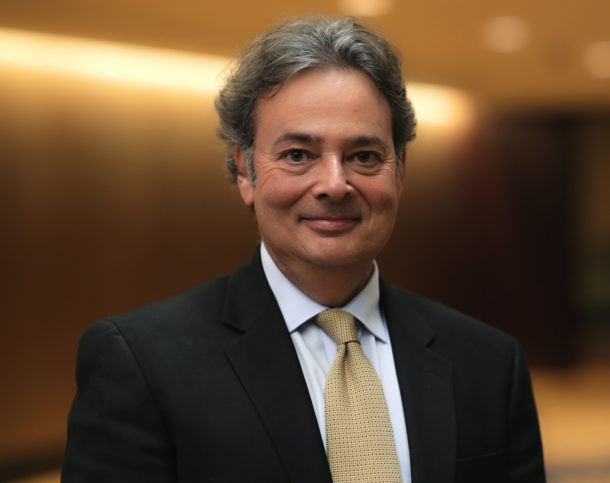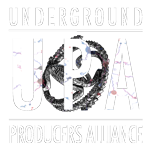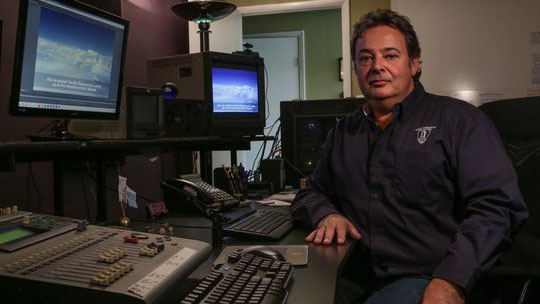UPA Director Raz Mesinai sat down with Ed Primeau to talk about his career in criminal investigation and audio.
I know that you went from the music industry to the field of audio forensics, could you tell us a bit about how that came about?
While employed at Ambience Recordings in Farmington Hills, Michigan, I was working as an audio engineer recording and producing radio commercials, as well as engineering music sessions. One day, the FBI called to schedule some studio time and none of the other engineers wanted to work with them. I was very interested and eager to do something different and gladly accepted the assignment.
The two Detroit FBI agents came in with a small NAGRA reel to reel recorder and several tapes. They asked me to remove the HVAC noise and enhance the dialogue on all of the tapes that they had brought.
I patched the output from the NAGRA to the input on the mixing board and listened to the noise interference. I then insert patched a parametric equalizer, as well as an LA-2A compressor, which did the trick. Once I could hear the dialogue I transferred the tapes on to a new reel to reel tape for their use in court. This was the first forensic assignment I had; back in 1984. At this time there was no real field of audio forensics, and I continued to do assignments as they came my way.
Once I felt confident in my forensic abilities, I then opened my doors as an entrepreneur in 1991. The cases kept coming in on a referral basis.
This question is responding to your analysis on the JFK tapes, which you found to be edited 14 times. Assuming that anyone who manipulated audio back then with a razor blade may not have imagined the technology that would come in the future to easily identify those edits (which I know to be pretty easy to find), and, considering the far more advanced tools for masking, editing, augmenting and overall tampering of recording we have today, what do you predict the future tools to combat these will be?
There are utilities available to the general public that are designed to detect edits within recordings. These utilities are not 100% accurate and do fail. They are mostly designed for consumer use and not expert use within the courtroom.
I have already experienced a software program that is capable of detecting edits, which they refer to as ‘butt splices’. I am not sure how the software interprets the digital audio information to locate these ‘butt splices’, however, I have experienced it in person. However, the results from the software program alone are not allowed to be used in the courtroom any longer. The error rate of such utilities is too high and inaccurate for expert witness testimony.
I believe that future software tools will continue to become more advanced, while still achieving higher rates of accuracy, but an expert’s interpretation of the data will always be required. An expert has experience and training required to interpret the data where a software program may fail. In addition, the examination of the fundamental basics of audio forensic authentication such as time & frequency domain, digital chain of custody and exemplar comparison analysis will remain as accurate information to analyze scientifically.
I find the history of the instruments for voice decoding and surveillance to also be related to the history of electronic music instruments (for example the Voder of the 30’s corresponds to synthesis concepts that we still use today or the great electronic instrument builder Leon Theramin being someone who later was to develop surveillance tools for Russia), do you believe that this still is the case today in the sense that one feeds the other?
Yes, absolutely. The music industry has directly influenced and affected the analysis of audio and video evidence in the courtroom as a science. The framework and workflow of software tools available for forensic analysis were created by some of this world’s top recording engineers & editors. I myself am an expert that was birthed from the audio
recording industry. To be completely honest, I know several audio enthusiasts that would be phenomenal (if not better than me) experts due to their knowledge of sound wave propagation and acoustics. The experience gained after spending years listening to recordings has trained my ears to enhance recordings forensically, and identify voices and perform forensic analysis of them.
In the case of Trayvon Martin, your analysis really struck a chord with me as you made it clear that your ear, developed over many years, could easily identify that the voice was indeed the voice of a child. Do you feel that today less or more emphasis is made on the ears ability to identify something like age, gender when it comes to forensics, or is technology needed as well in order to make a solid case. (pretty obvious question I guess, but hoping it will open a conversation).
Great question! I have expressed the importance of critical listening for as long as I can remember. It is one of the analysis techniques that has helped me grow a career as an audio forensic expert. Critical listening is an important asset to anybody engaged in audio engineering, as well as audio forensics. There are subjective and objective opinions and they need to be balanced using science as the anchor in forensics. My opinion about the Trayvon Martin cries for help was strictly subjective and lacked scientific proof. In answer to your question, the subjective reasoning alone would NOT hold up as a solid case in court.
My solution to the investigation for a stronger scientifically supported analysis was for a sample be created of George Zimmerman’s voice. This voice would then be analyzed so that biometric measurement could be used for the voice identification process. Even though that process was executed, it is my opinion that it wasn’t performed accurately and the outcome never made it to the Trier of Fact.
I have been trained with biometric software that is capable of identifying or eliminating a known voice sample against an unknown voice sample. That technology requires extensive preparation in order for the software to function accurately. Biometric software cannot identify a voice that is absent dialogue. It is actually a stretch to be able to opine like I did in the Trayvon Martin case subjectively. Critical listening and experience with voice identification and speech analysis was crucial in expressing my opinion during that case.
I was on the witness list for the prosecution, but never testified. An FBI Voice Identification forensic expert testified that voice identification was not a reliable science, absent dialogue. Therefore, none of the voice identification experts were able to testify in that case.
We have new tools now for re-creating the voice of anyone and even adding emotional cadence with the rise of focus on AI, such as Lyrebird, how will we be able to combat this in the case of forensics when the technology is nearly indecipherable from the real thing?
There are several software programs that are in use that I have not been made aware of. I am almost certain that the United States government has software programs that the general public will never have knowledge of. There are also other countries with technology that we haven’t even heard about either. Software like Lyrebird and other speech synthesis programs are becoming more advanced, I agree. And because of this, it is becoming more and more difficult to determine if the formants in a recording are genuine. These are the most important parts of speech we extract data from for Voice Identification. Because of these facts and many others, the scientific community is becoming less supportive of Voice ID as an acceptable, reliable and accurate science in the courtroom. I have not personally experienced an example of an unknown voice synthesis matching a known person’s voice, but perhaps that day will come when I do.
Did you ever find some cases to be too difficult? If so, why?
I have never worked on a case that I was not able to provide an answer to my client through. If they were a litigator, judge, police officer, federal investigator, or private citizen, I always make an effort to interpret the evidence forensically and help them strategize their case. With that being said, they aren’t all easy. Some cases require more lab time than others to not only research and analyze but investigate. I always like to explain to a client attorney how their evidence will be perceived in court. A good investigator wants the good news as well as the bad news.
In some cases I even spend my own time researching information about the case in order to satisfy the investigator. When you look at it that way, all cases are difficult, yet an outcome can still be provided.
With the issues facing musicians and producers in the music industry today, do you find any of the same issues affecting your field at all? For example “live” forensics being replaced by algorithmic programs that do them on their own, or will it always need that human touch? I sure hope so!
Automatic enhancements: filtering to be applied, order of filters, intensity of filters, deductive reasoning (maybe this will work maybe that will work).
They will always need that human touch because computers do not process information like the human brain. I have not come across any issues like you refer to in the music industry that apply to audio forensics. Audio experts testify in court because they have more training and experience to interpret evidence for the trier of fact unlike any software program I have ever seen.
I have investigated cases in the past where music samples were used to create new songs and the artist whose music was used to create the sample sued the artist that created the sample. I have also had cases where auditions were used in motion pictures without paying the talent fees to the voice that was used. We will always have challenges and there will always be litigation.
We at the UPA find that critical listening is absolutely vital to the act of creating music, and id dare say your ear must be the most critical, what are your thoughts on this, and has your ear affected your experience listening to music?
Yes, I agree completely. The point of reference is found in critical listening. When you know how to listen critically to the recording and identify characteristics like tonality, room size, attack, pitch – then you know how to have a point of reference when trying to recreate these sounds. Bob Seger came into Ambience Recording Studio one day when we were working on his second live album Nine Tonight. He brought in a cassette tape demo called Born in the USA that he and Bruce Springsteen listened to while driving through the desert the previous week. He said to us emphatically ‘I want that snare sound!’ So we listened to it and we recreated it using a harmonizer and a lexicon. We played the cassette tape, listened to it, played the recording, listened to it; developed a point of reference. We played the snare sound on Bob’s recording and adjusted the parameters on the Lexicon and Harmonizer accordingly until we saw him smile. Then we knew we got the sound.
I apply this basic framework of critical listening to my investigations on a daily basis; by identifying the wanted and unwanted sounds in a recording, as well as their location in a recording. Then, identifying the tools to use and applying them in a way to reduce the unwanted signals and increase the wanted signals. Still critical listening, still identifying the sounds, but instead of recreating them, we are making them sound better. When training my experts, critical listening is chapter one in the book.
Lastly, at the UPA we do a lot of field recordings, which we use as ways of determining how acoustical spaces sound, aside from sound design for film, I recommend to students to look into forensics as well, what advice would you give to students looking to explore the world of Audio Forensics, and whatexercises would you recommend for them to develop their ear further?
The first and most important step is understanding frequency range. Where do instrument sounds fall on the sound spectrum? Where do buzzes and hums, car sounds, HVAC, car horns fall in the sound spectrum? Using an equalizer, various types of headphones and monitors will help develop the student’s critical listening skills over time.
I also recommend anyone engaged in audio recording have a hearing test. This hearing test will help identify any sound perception discrepancy the individual may have. Also, the hearing test will service as confirmation that an audio forensic expert’s hearing is accurate. In any field of audio engineering, you must have a good sense of hearing. While in the education phase of your career, you may not be aware of any limitations to your sound perception. The more field experience you have in different environments, the more experience you are going to have in developing your perception of sound. Learn and gain experience in the various types of software programs that audio forensic experts use like iZotope RX, Adobe Audition and Sony SoundForge. All of these types of software offer student discounted pricing as well as trials to gain experience. Learning to operate this software hands on, as well as with video training, will help advance the aspiring forensic expert.
In addition, internships are a way to get into the professional world. A good internship with a company that specializes in an area of audio engineering will give you the opportunities to gain experience with the software, communication skills, writing skills, office etiquette and media/case management.
Ed will be a mentor for this year’s Sound Design Career Development Program.
For more information www.primeauforensics.com/






Leave a reply